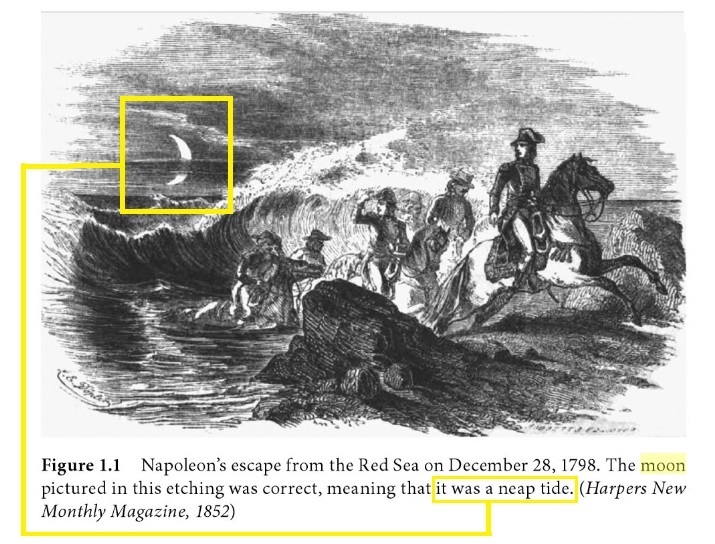I decided to track down, once and for all, the definitive description of Napoleon’s encounter with the Red Sea … Behold:
The Power of the Sea: Tsunamis, Storm Surges, Rogue Waves, and Our Quest to … By Bruce Parker (Pages 7, 9-13)
On July 25, 1798, Napoleon Bonaparte entered Cairo as the master of all Egypt after defeating the Egyptian Mamluks in the Battle of the Pyramids.
On the morning of December 28 Napoleon intended to take a small band of soldiers to visit the Wells of Moses, on the other side of the Gulf of Suez at the northern end of the Red Sea. The Gulf o f Suez extended about three miles farther north of the port of Suez in 1798 than it does today. The point where Napoleon expected to cross the Gulf of Suez was about one mile wide and always dry, or at least fordable, at low tide. Caravans from Tor and Mount Sinai regularly crossed at this spot.
Predicting the time of low tide at that location on the morning of December 28 would have been no problem for Napoleon’s scientists. By 1798 tide prediction had finally become a scientific endeavor…
Throughout the centuries the locals living along this French coast [near the cone-shaped rocky isle of Mont-Saint-Michel at the southeastern end of the Gulf of St. Malo, connected to the English Channel] have described the incoming tide as arriving like galloping horses, swiftly encircling the Benedictine abbey that has been on Mont-Saint-Michel since AD 708. Fishermen caught on this expanse of mudflats at the wrong time found themselves suddenly surrounded by water
rushing in at them on all sides. Many drowned.
The tidal range at the northern end of the Red Sea was not nearly as large as the tidal range near Mont-Saint-Michel, but even an eight-foot range could cause problems for one caught on a mud or sand flat when the tide comes in. So an accurate tide prediction was important for Napoleon.
When he and his men reached the shore of the Gulf of Suez at the scheduled time, he found a mile-long expanse of sea bottom exposed at low tide as his scientists had predicted. His small band of soldiers on horseback easily crossed the dry flats to the other coast before the tide began to rise… late in the afternoon he and his men left and began their return trip to Suez.
The sun had set by the time Napoleon and his soldiers reached the seashore. The tide seemed to be out far enough for them to begin crossing the exposed sea bottom. But the sea bottom did
not stay exposed for long.
Suddenly the tide began rushing in at them, seemingly from all directions. Surrounded by rapidly rising water, and with darkness adding to their confusion, they were thrown into disorder and panic. They could not see a shoreline in any direction. As the tide rose, the water quickly became deeper and threatened to engulf them. Their only chance was to find a shoal where the water might still be shallow enough to walk on.
Napoleon calmed his men and ordered them to form concentric circles around him, each horseman facing outward as part of several straight lines pointing out in different directions, like the spokes of a wheel. He then ordered each line of horsemen to advance outward. Then the lead horse of a line
reached deeper water and had to begin desperately swimming, that column drew back and followed one of the columns still walking on the sea bottom.
Eventually, each of the columns lost their footing until only one remained, which everyone followed to an ultimate escape from the Red Sea…
Back on shore Napoleon is said to have remarked, “Had I perished in that manner, like Pharaoh, it would have furnished all the preachers of Christendom with a magnificent text against me.” . . . The[ir] location [of Moses] was probably farther north than where Napoleon almost met his demise, because in the time of Moses [the] sea level was higher than it was in Napoleon’s time…
… at the time of Napoleon’s escape from the onrushing tide, his private secretary and the author of his memoirs, Louis de Bourrienne, said that at high tide the water rose five or six feet and as much as nine or ten feet with the wind blowing in the right direction. We know from astronomical calculations that the tide that engulfed Napoleon and his men was only a neap tide.
… the moon was in its third quarter. Napoleon might not have escaped the Red Sea if there had been a nearly full or new moon, which brings the larger spring tide. Napoleon’s sudden encounter with the onrushing tide was shocking enough…
… [A]s it turns out [the] suggestion that Moses might have planned to cross the Sea of Reeds at the predicted time of a low tide turns out not to be a new suggestion. In Praeparatio Evangelica (Preparation for the Gospel), Eusebius of Caesarea (ca. AD 263-339) quotes from a book by the
Hellenistic historian Artapanus (80-40 BCE). In that quote Artapanus gives two versions of the crossing of the Red Sea. One is a story similar to what appears in the Bible, which he
attributes to the people of Heliopolis.
The second version he summarizes thus: “Now the people of Memphis say, that Moses being acquainted with the country waited for the ebb, and took the people across the sea when
dry.”
[END OF CLIP]
The link to the Google Book version is below:
